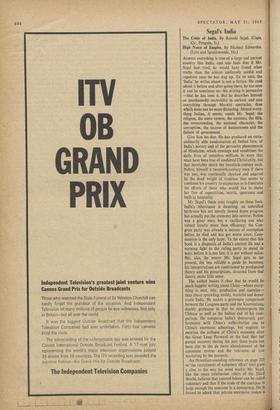Segal's India
High Noon of Empire. By Michael Edwardes. (Eyre and Spottiswoode, 35s.) ALMOST everything is true of a large and ancient country like India, and one feels that if Mr. Segal had tried, he would have found other truths than the almost uniformly sordid and repulsive ones he has dug up. To be sure, the `India' he writes about is not a fiction. He read about it before and after going there, he has seen it and be convinces us—his writing is persuasive —that he has seen it. But he describes himself as unashamedly materialist in outlook and sees everything through Marxist spectacles, than which none can be more distorting. Almost every- thing Indian, it seems, repels Mr. Segal: the religion, the caste system, the customs, the filth, the overcrowding, the national character, the corruption, the success of businessmen and the failure of government.
Give him his due. He has produced an extra- ordinarily able condensation of Indian lore, of India's history and of the pervasive phenomenon of Hinduism, which envelops and conditions the daily lives of countless millions in ways that must have been true of mediaeval Christianity, but that inevitably shock the twentieth-century man. Nehru, himself a twentieth-century man if there was one, was continually shocked and angered by the dead weight of tradition that seems to condemn his country to stagnation as it frustrates the efforts of those who would like to shake her free of superstition, inertia, ignorance and built-in inequality.
Mr. Segal's thesis runs roughly on these lines. India's inheritance is daunting; an unbridled birth-rate has not merely slowed down progress but actually put the economy into reverse; Nehru was a great man, but a vacillating one who valued loyalty more than efficiency; the Con- gress party was already a morass of corruption before he died and has got worse since; Com- munism is the only hope. To the extent that this book is a diagnosis of India's ancient ills and a warning light to the ruling party to mend its ways before it is too late, it is not without value.
But, alas, the nearer Mr. Segal gets to the present, the less reliable a guide he becomes; his interpretations are conditioned by predigested theory and his prescriptions, divorced from that theory, make little sense.
The author makes it clear that he would be much happier writing about China—where every-
thing is neat, tidy, productive and coercive—
than about sprawling, untidy, wasteful and demo- cratic India. He makes a grotesque comparison between the Congress party and the Kuomintang, doubly grotesque in that he misinterprets the Chinese as well as the Indian end of his com- parison. He compares India's democratic per- formance with China's authoritarian one to China's enormous advantage, but neglects to mention the collapse of China's economy after the Great Leap Forward or the fact that her partial recovery during the past three years has been due to the de facto abandonment of the commune system and the tolerance of free marketing by the peasants.
An Orwellian-sounding reference on page 225 to 'the recruitment of voluntary effort' (sic) gives a clue to the way his mind works. Mr. Segal, like the more totalitarian rulers of the Third World, believes that coerced labour can be called voluntary and that if the scale of the coercion is large enough the outcome is a democracy. He is forced to admit that private enterprise makes a
disproportionate contribution to India's output, in comparison with the public sector, then goes on to conclude-as doubtless Mr. George Brown, in another context, would-that the public sec- tor must absorb the private. Does he not see that the result would be a deepening of India's desperate poverty?
He calls for 'not less Communism but more' in, of all things, agriculture. Has he never heard of what Communism has done to agriculture, from East Germany to North Vietnam? The plain fact, which • so many intellectuals .seem unable to grasp, is that there is no connection between social justice and state control of the means of production. If India's economists-and Mr. Wilson's-saw this, there would be less waste and more wealth to distribute. Then India might aspire to emulate not China but Japan-an in- finitely more desirable model for all under- developed countries.
The vanished India of Lord Cprzon, that 'great imperial revolutionary,' which Mr. Edwardes ably reconstructs, was a tidier place than the one Mr. Segal saw, but even less likely to please him.
BRIAN CROZIER































 Previous page
Previous page